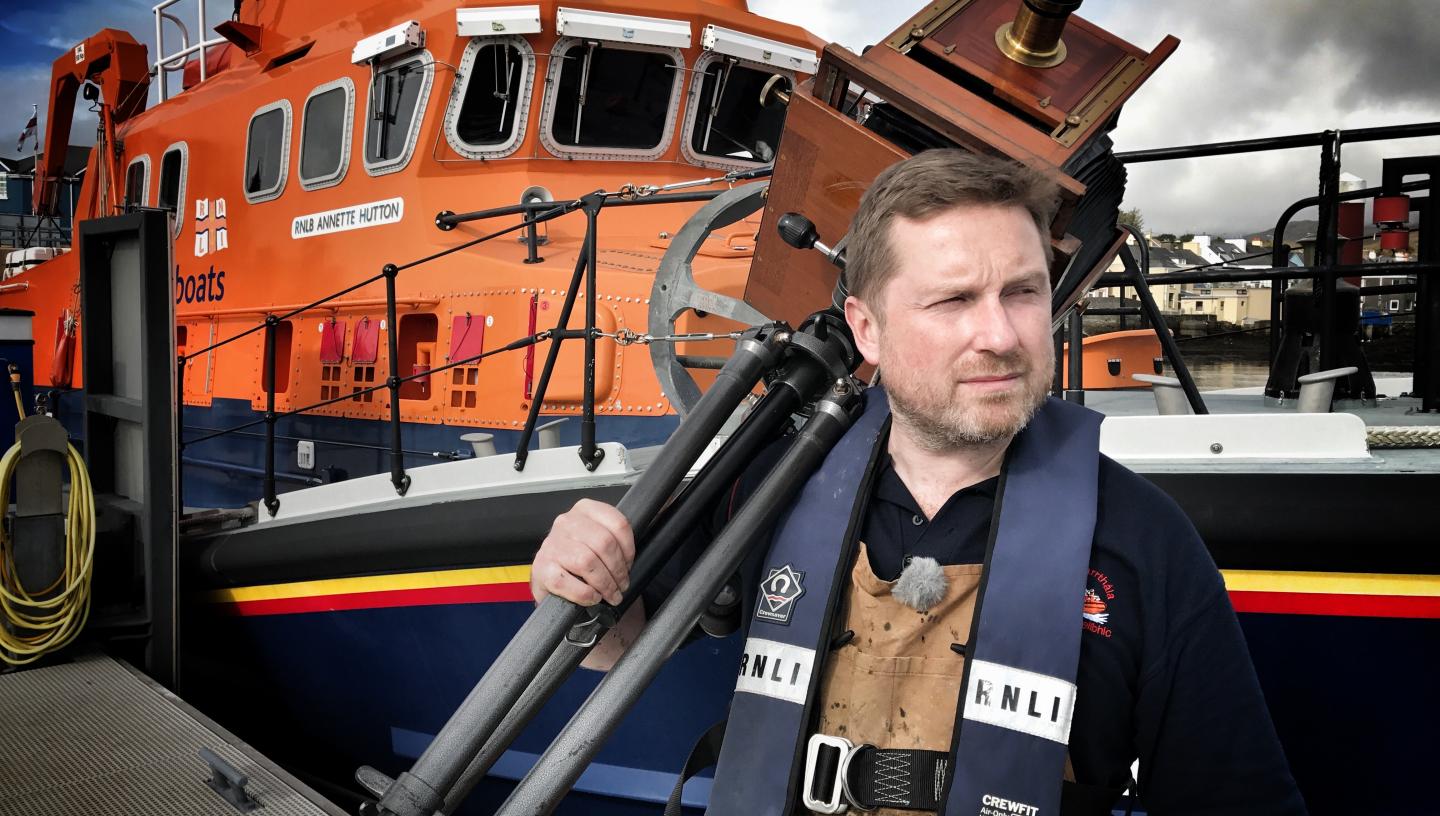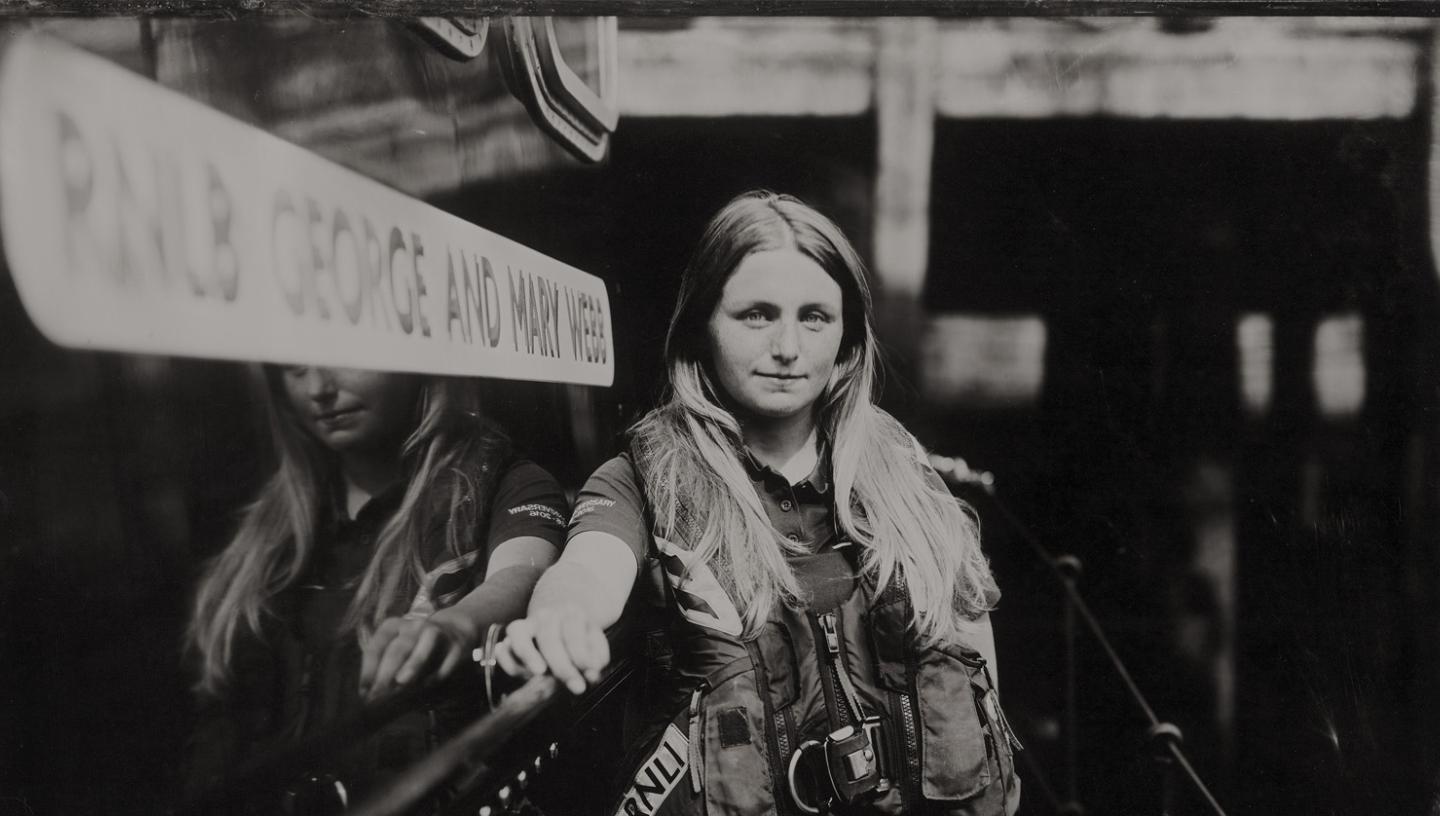
A hot June day. In the harbour town of Ilfracombe in North Devon, an RNLI lifeboat is positioned on the slipway. Standing on and around the vessel are 27 crew members, staring intently.
They are looking at an Edwardian camera made of brass-bound mahogany, mounted on a tripod. After several seconds, a figure emerges from beneath the camera’s focusing cloth.
This is Jack Lowe, award-winning photographer and creator of The Lifeboat Station Project. Since 2015, Jack has been on a mission to photograph the crew members at all 238 RNLI lifeboat stations. It’s an endeavour that has taken him across the UK and Ireland, from the coastline of Ballycotton to the colourful harbour of Kirkwall.
To produce his glass-plate images, Jack uses a Victorian process called wet collodion – a method used around the time of the RNLI’s early history.
His photographs formed the centrepiece of Women of the RNLI, a 2024 exhibition at the National Maritime Museum.
From initial inspiration to new perspectives, Jack gives an insight into how he captures his images.
What was the inspiration behind The Lifeboat Station Project?

It’s quite a classic story really – some may even say clichéd! When I was around eight or nine my grandmother gave me my first camera: her mother’s Kodak Instamatic. As soon as she handed it to me, I realised I had a window into photography.
I loved the equipment and processes. I converted my bedroom into a darkroom and taught myself how to process film and print from the negatives – it was like magic.
Around this time, my dad introduced me to the wonders of lifeboats. He took me to Cowes in the Isle of Wight to see where the inshore lifeboats were built. That was another lightbulb moment. I knew then that I wanted to be a photographer and a lifeboatman.
I’ve always worked in photography, but in 2010 I had a realisation. I had gone on this decade-long tangent of making prints for other photographers and I thought, “Where’s my photography? I want to do something that’s special.”
I looked back to my childhood passions for inspiration, and I ended up writing three things on a piece of paper: ‘photography, lifeboats and the sea.’
The idea came to me a few years later over a cup of tea. I saw the RNLI lifeboat stations tea towel on the back of the kitchen door, and I thought: “I can do something with that, surely?”
I’m an obsessive character: when I get into something, I really get into it and do it. I proposed – and later reproposed – the project to the RNLI, and in 2014, I was given the institution’s blessing to go ahead.
Follow the story
Sign up to our newsletter to hear more about upcoming exhibitions and events from Royal Museums Greenwich.
Why did you choose to use Victorian glass-plate technology to capture your pictures?
I wanted to reignite those feelings I had as a kid, when I converted my bedroom into a darkroom and could see the photographs appearing in the chemicals.
I decided to research the history of photography and stumbled across wet collodion. It was one of the first mainstream photographic processes, invented in 1851 – just a few decades after the RNLI was founded.
A piece of glass or metal is coated with chemicals to make it light sensitive. The sensitised plate is placed in the camera and after exposure is immediately carried back to a darkroom for processing. It’s a beautiful process: it’s immediate, tangible – you can see it happening before your very eyes.
This was the secret ingredient to The Lifeboat Station Project idea I had been developing. I could imagine a situation where I would turn up at a lifeboat station with an old camera and make a photograph with a method used to take the very first pictures of lifeboat crews. The crew could see the finished result right there and then.
You’ve taken pictures of 158 lifeboat stations. What does a shoot day involve?

There’s a lot to remember, but because I’ve made thousands of pictures for the project everything now flows from me.
I make a few photographs during my visit to any lifeboat station, from images of the crew to a picture of the view from the boathouse. After I've composed the photograph – taking into account the fact that old cameras display the image upside down and back to front – I need to handmake the photographic film. This is done in my mobile darkroom called Neena, a decommissioned NHS ambulance.
I have to make the photographic film for each glass plate moments before taking the photograph. I pour the chemical collodion onto the glass and put the plate in a light-proof box of silver nitrate to make it light sensitive.
After about three minutes I take the plate out of the box. The moment I do this, I’m on the clock. The glass is now coated in wet chemicals, and if it dries out it won’t be able to record an image.
I rub the excess chemicals off the back of the plate and put it into the wooden plate holder, which plugs into the back of the camera.
It can be quite pressured, especially when there are around 30 lifeboat crew patiently waiting for you to take the image. They already devote so much time to lifeboat service, and here they are taking part in this as well.
However, the crew know that as soon as I come out of Neena and head over to the camera with the plate holder, they need to be paying attention. I've already briefed them beforehand: one of the first things I say to them is, “Anything you think you know about photography, forget it!”
I carefully arrange them so they’re leaning against something. They might be resting against a piece of equipment or shoulder-to-shoulder with somebody else. The camera has a few seconds’ exposure time, and with the best will in the world you can’t stand for that long without there being some movement.
Once the plate holder is plugged into the camera, the plate is exposed. I give the crew a countdown, during which time I encourage them to slowly breathe out, so they’re anchoring themselves in their diaphragm. They need to have an expression they're comfortable holding. I tell them that if they think happy thoughts, that will come through in their eyes. They can also blink as it’s too quick to be registered by the long exposure.
I then remove the lens cap, count for about six or seven elephants, take the holder off the camera and dash off to Neena to process the plate. I have two minutes to pour the developer over the plate, and then must add water at exactly the right time to stop the development action. When the plate’s been properly developed, it has a vinegary smell, and is no longer light sensitive.
This is the magical moment when I can open Neena’s side door, get the crew to huddle around, watch me pour the fixer over the plate and see the image come to life.
Even though the final glass plates are beautiful objects, what people actually remember is the fantastic day and memories we’ve made together.
What has been the reaction to your work?
It’s been amazing to see lifeboat crews walking away with their chest puffed out, head held high, and for them to feel they’ve had a light shone on their work.
While film or digital photographs capture a moment that lasts a fraction of a second, because glass-plate photography has a much longer exposure length – around 7-12 seconds – you get an insight into a period of somebody’s life. You get the sense that you’re looking at heartbeats and thoughts and feelings.
After I shot the crew photograph at Ilfracombe, one of the volunteers said, “We look like those heroes of old,” and I said, “That’s because you are those heroes of old.” While he had seen colour photographs of the crew and had been photographed lots of times, he never had the sense that he was like those people that had inspired him to join the RNLI.
This one photograph made him realise that he was that person too. It was a wonderful thing for me to be able to help somebody feel that way.
How has The Lifeboat Station Project shaped you?
The project has taught me that when you slow down, the world opens up before you. It’s made me much more humble and community-minded. When I first started, I was bolshy – I had to be to make a project of this size work.
Then I read An Astronaut's Guide to Life on Earth by Chris Hadfield, the commander on the International Space Station, and I came across this sentence: “You need to go in as a zero.”
I realised that what I was making with The Lifeboat Station Project wasn’t about me. It was about understanding that the RNLI communities have been here for a long time, and this project is helping to preserve a vital slice of island life for future generations. The RNLI is a beautiful charity that brings together people who are prepared to drop everything and to help somebody they don’t even know.
I do feel immensely proud that I have this collaboration with the National Maritime Museum, where I always dreamed my work would end up. Whatever happens from this point, from discovering my passion for photography as a child to having photographed two-thirds of the RNLI network, this partnership feels correct. For me, the exhibition has been a real ray of light in these turbulent times.

Women of the RNLI
As told to Elizabeth Oliver, Digital Content Producer at Royal Museums Greenwich
Main image: Duncan Davis





